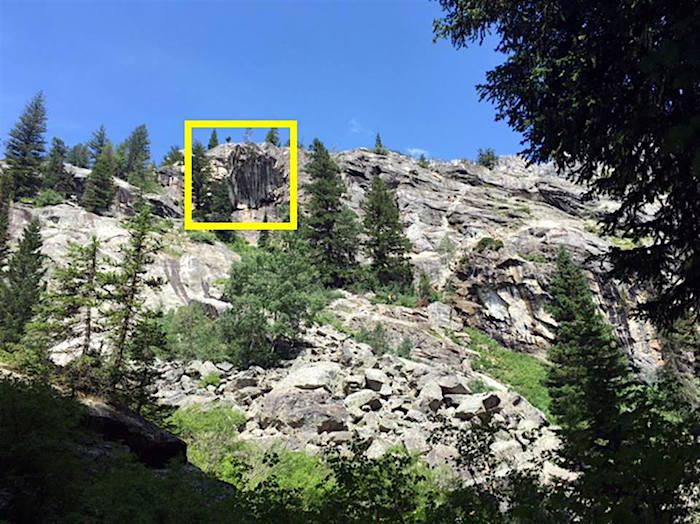
This rock buttress above Hidden Falls in Grand Teton National Park could be a risk to collapse/NPS
Hidden Falls, one of the most popular destinations in Grand Teton National Park for visitors, remains closed indefinitely as geologists try to determine whether a rock buttress above the falls is a threat to collapse in the near future.
While the Hidden Falls viewing area is currently closed "out of an abundance of caution," the park staff said in a release, the Jenny Lake area -- including Cascade Canyon, the loop trail around the lake, the shuttle boat, and a scenic hike along a cascade and up to a Jenny Lake viewpoint -- remains open.
On July 10, climbing guides alerted park rangers to movement in the rock buttress that was believed to have recently occurred. After evaluating the situation, park rangers closed the area out of concern that the rock, which is about 100 feet long, 20 feet high, and 20 feet wide, could come loose and fall onto the highly visited Hidden Falls viewing area.
Rockfall is a common occurrence in the Teton Range, and is a part of the naturally dynamic environment of mountains. As a relatively young mountain range, the Tetons are still rising and actively eroding. Over long periods of time, water flowing through minute fractures decomposes rock in a process called "weathering." Once a rock has been weathered, triggers such as freeze-thaw cycles, flowing water, temperature variations, vegetation growth, and other factors can cause cracks in rock to grow rapidly and possibly break free and fall.
Park staff are using multiple methods to monitor the situation. Time-lapse cameras have been installed to allow the scientists to view growth in the crack as well as any changes to the buttress at 15-minute intervals. Scientists are also working with park rangers to manually measure the width of the crack at multiple locations at least once each day.

GPS measurements are helping scientists tell whether rock buttress is moving/NPS
Scientists are using an additional monitoring technique called structure-from-motion, which has recently become popular in the geosciences field. This photogrammetry technique involves taking numerous photos and high-accuracy GPS readings to develop three-dimensional models of an object. Scientists are able to use structure-from-motion to assess how the rock may be moving and in what direction.
Since July 10, staff have not observed significant change in the crack on a scale they can detect. After additional investigation and discussion with climbing guides who routinely visit the area, it is believed that the crack may have begun to expand last fall, and it is uncertain whether additional expansion occurred recently, as initially thought, or over the winter and spring when freeze-thaw cycles may have contributed.
Park scientists are consulting with subject matter experts from the National Park Service Geologic Resources Division, Yosemite National Park, and United States Geological Survey Landslide Hazards Program to develop a risk assessment for the area as well as additional high-precision monitoring methods.

Crack in rock buttress above Hidden Falls at Grand Teton National Park/NPS





